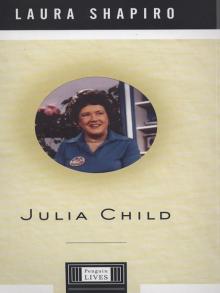- Home
- Julia Child
Mastering the Art of French Cooking, Volume 1 Page 14
Mastering the Art of French Cooking, Volume 1 Read online
Page 14
SUBSTITUTES FOR HOMEMADE STOCK
If you do not have a homemade stock in the larder, you can always use canned beef bouillon, canned chicken broth, canned mushroom broth, or bottled clam juice. Such economical substitutes for stock are not usually available to French cooks, and when simmered with meats, or with wine and aromatic vegetables, these canned alternatives are entirely satisfactory. A recipe for improving canned beef bouillon is on this page; for canned chicken broth; and for bottled clam juice. Bouillon cubes are less successful, but they should certainly be used in an emergency. Canned consommé tends to be sweet and we do not recommend it.
INGREDIENTS FOR MAKING STOCKS
The most luxurious stocks are made from fresh soup bones, fresh meat, and vegetables. But unless you intend to make a stock for an absolutely remarkable consommé, use what you have on hand and add any fresh ingredients you wish to buy. It is a good idea to make a collection in the freezer of beef, veal, and poultry bones, and meat scraps. Then when a sufficient amount has accumulated, you can boil up a stock. Both meat and bones give flavor, and the bones, in addition, contain a certain amount of gelatin which gives body to the stock. Raw veal bones, especially the knuckle, and calf’s feet, if you can find them, contain the most gelatin. If you want a stock that will jell naturally, include these in the proportions listed.
Lamb, Ham, and Pork
A few pork bones may be added to the stock kettle, but too much pork tends to give the stock a sweet flavor. Lamb or ham bones should not be used; their flavor is too strong for a general-purpose stock. But lamb or ham stocks are made in the same way as simple stock.
Vegetables
Carrots, onions, celery, and leeks are the usual soup vegetables. A parsnip or two may be included if you wish. Starchy vegetables will cloud the stock. Turnips, cauliflower, and the cabbage family in general have too strong a flavor for a general-purpose stock.
THE PRESSURE COOKER
One would expect a pressure cooker to be the ideal stock-making instrument; but our experiments have shown otherwise. After about 45 minutes of cooking under 15 pounds of pressure, a meat stock acquires its maximum pressure-cooked flavor. To reach its optimum flavor, it must then be simmered quietly in an open pot an hour or two more. Poultry stock, in our experience, acquires an unpleasant flavor if cooked for more than 20 minutes under 15 pounds of pressure. After this lapse of time the pressure should be released and the stock allowed to simmer, uncovered, for an hour or so longer.
FONDS DE CUISINE SIMPLE
[Simple Meat Stock]
This is the general formula for a simple stock made from a miscellaneous collection of bones and meat scraps. It may be employed for meat sauces, the braising of meats and vegetables, the flavoring of soups, and for deglazing a roasting pan. The stock may be made from bones alone, but will have more character if some meat is included; ideal proportions are about half and half. The more elaborate stocks follow exactly the same cooking procedure.
For 2 to 3 quarts
3 quarts of meat and bones chopped into 2- to 3-inch pieces (raw or cooked veal or beef bones and meat, and/or poultry carcasses, scraps, and giblets)
An 8- to 10-quart kettle
Cold water
Place the meat and bones in the kettle and add cold water to cover them by 2 inches. Set over moderate heat. As the liquid comes slowly to the simmer, scum will start to rise. Remove it with a spoon or ladle for 5 minutes or so, until it almost ceases to accumulate.
2 tsp salt
2 medium-sized scraped carrots
2 medium-sized peeled onions
2 medium-sized celery stalks
The following tied in washed cheesecloth:
¼ tsp thyme
1 bay leaf
6 parsley sprigs
2 unpeeled garlic cloves
2 whole cloves
Optional: 2 washed leeks
Add all the ingredients at the left, and more water if the liquid does not cover the ingredients by a full inch. When liquid is simmering again, skim as necessary. Partially cover the kettle, leaving a space of about 1 inch for steam to escape. Maintain liquid at a very quiet simmer—just a bubble or two of motion at the surface—for 4 to 5 hours or more. Accumulated fat and scum may be skimmed off occasionally. Boiling water should be added if the liquid evaporates below the level of the ingredients.
Never allow the liquid to boil; fat and scum incorporate themselves into the stock and will make it cloudy.
Cooking may be stopped at any time, and continued later.
Never cover the kettle airtight unless its contents have cooled completely, or the stock will sour.
When your taste convinces you that you have simmered the most out of your ingredients, strain the stock out of the kettle into a bowl.
TO DEGREASE
Either let the stock settle for 5 minutes, remove the fat from its surface with a spoon or ladle, then draw scraps of paper toweling over the top of the stock to blot up the last globules of fat;
Or set the stock, uncovered, in the refrigerator until the fat has hardened on the surface and can be scraped off.
FINAL FLAVORING
Taste the degreased stock for strength. If its flavor is weak, boil it down to evaporate some of its water content and to concentrate its strength. Correct seasoning, and it is ready to use.
STORAGE
When the stock is cold, cover and refrigerate it, or bottle and freeze it. Stock kept in the refrigerator must be brought to the boil every 3 or 4 days to keep it from spoiling.
VARIATIONS
The following are traditional recipes for classical stocks made with fresh ingredients. You can, of course, vary the proportions according to your pocket-book and store of leftover bones and meat scraps. These are all simmered in exactly the same way as the simple stock in the preceding master recipe.
Fonds Blanc
[White Stock — Veal Stock]
White stock is used when you want to make a particularly fine white velouté sauce or soup. Raw veal releases a tremendous amount of gray and granular scum that can cloud your stock if it is not completely removed. The easiest way to deal with this problem is to blanch the veal as described here.
For 2 to 3 quarts
3 lbs. lean, raw veal shank meat
4 lbs. cracked, raw veal bones
Place the meat and bones in a kettle. Cover with cold water, bring to the boil and boil slowly for 5 minutes. Drain, and rinse the bones and meat under cold water to remove all scum. Rinse the kettle clean.
Same vegetables, herbs, and seasonings as for the master recipe
Place the bones and meat again in the kettle, cover with cold water, bring to the simmer, and skim as necessary. Then add the vegetables, herbs, and seasonings. Simmer the stock for 4 to 5 hours or more as described in the master recipe.
Fonds Blanc de Volaille
[White Poultry Stock]
This stock is used for soups and sauces. Employ the same method and ingredients as for the preceding white veal stock, but add a whole or parts of a stewing hen to the kettle along with the vegetables. The chicken may be removed when tender, and the stock simmered several hours longer.
Fonds Brun
[Brown Stock]
Brown stock is used for brown sauces, consommés, and for the braising of vegetables and red meats. To give the stock a good color, the meat, bones, and vegetables are browned before they go into the kettle, otherwise the cooking procedure is the same as for a simple stock, which may also be turned into a brown stock if you brown the ingredients.
For 3 to 4 quarts
A shallow roasting pan
3 lbs. beef shank meat
3 to 4 lbs. cracked beef and veal bones
2 scrubbed, quartered carrots
2 halved, peeled onions
Heat oven to 450 degrees. Arrange the meat, bones, and vegetables in the roasting pan and place in the middle portion of the oven. Turn the ingredients occasionally so they will brown evenly, in 30 to 40 minutes.
<
br /> An 8- to 10-quart kettle
Remove from oven and drain fat out of roasting pan. Transfer the browned ingredients to a soup kettle. Pour a cup or two of water into the pan, set over heat, and scrape up all coagulated browning juices. Pour them into the kettle.
2 tsp salt
2 celery stalks
Herbs and flavorings listed in the master recipe, tied in cheesecloth
Then, following the procedure in the master recipe cover the ingredients in the kettle with cold water, bring to the simmer, skim. Add the ingredients at the left and proceed with the recipe. Simmer the stock 4 to 5 hours or more.
Fonds Brun de Volaille
[Brown Poultry Stock]
The recipe for a simple brown poultry stock is in the Poultry chapter. You will note that poultry bones and scraps should be browned in a skillet, as they tend to burn and to acquire an unpleasant flavor if browned in the oven.
Glace de Viande
[Meat Glaze]
Meat glaze is any one of the preceding stocks boiled down until it has reduced to a syrup that becomes a hard jelly when it is cold. Three quarts of stock will reduce to 1½ cups or less of glaze, so it is easily stored. Half a teaspoon stirred into a sauce or a soup will often give it just that particular boost of flavor which it lacks. Meat glaze dissolved in hot water may always be used in place of stock. It is thus a most useful commodity to have on hand and almost invariably has a better flavor than commercial meat extracts and bouillon cubes.
2 to 3 quarts of any homemade stock
Strain the stock and degrease it thoroughly. Bring it to the boil in an uncovered saucepan and boil it slowly until it has reduced to about 1 quart. Strain it through a very fine sieve into a smaller saucepan and continue to boil it down until it has reduced to a syrup which coats the spoon lightly. Watch it during the last stages to be sure it does not burn. Strain it into a jar. When it is cold and has turned to a jelly, cover and refrigerate, or freeze it.
Meat glaze will keep for weeks under refrigeration. If it develops a few spots of mold, no harm is done. Pry it out of its jar, wash it under warm water. Then simmer it in a saucepan over low heat with a spoonful of water until it has again reduced to a thick syrup.
CLARIFICATION OF STOCK
Clarification du Bouillon
If you wish to serve a rich homemade consommé, jellied soup, or aspic, you should clarify your stock so it is beautifully clear and sparkling. This is accomplished by beating egg whites into cold stock, then heating it to just below the simmer for 15 minutes. The egg-white globules dispersed into the stock act as a magnet for all its minute cloudy particles. These gradually rise to the surface, leaving a crystal-clear liquid below them.
Clarification is a simple process if you remember that the stock must be perfectly degreased, that all equipment must be absolutely free of grease, and that you must handle the stock gently so the egg whites are not unduly disturbed.
For about 1 quart
5 cups cold stock
Salt and pepper
A very clean 2 ½-quart saucepan
Degrease the stock thoroughly; any fat particles will hinder the clarification process. Taste carefully for seasoning and oversalt slightly if stock is to be served cold; salt loses savor in a cold dish.
A very clean 2-quart mixing bowl
A wire whip
2 egg whites
Optional: ¼ cup or 2 ounces of absolutely lean, scraped, or minced beef
¼ cup minced green leek tops or green onion tops
2 Tb minced parsley
½ Tb tarragon or chervil
Beat 1 cup of stock in the mixing bowl with the egg whites and add optional ingredients for richer flavor. Bring the rest of the stock to the boil in the saucepan. Then, beating the egg-white mixture, gradually pour on the hot stock in a very thin stream. Pour the mixture back into the saucepan and set over moderate heat. Until the stock reaches the simmer, agitate it slowly and continually with a wire whip so that the egg whites, which will begin to turn white, are being constantly circulated throughout the liquid. Immediately the simmer is reached, stop stirring. The egg whites now will have mounted to the surface. Gently move the saucepan to the side of the heat so that one edge of the liquid is barely bubbling. In 5 minutes, rotate the saucepan a quarter turn. Turn it again in 5 minutes, and once more for a final 5 minutes.
5 layers of well-washed, damp cheesecloth
A very clean colander
A very clean 3-quart bowl
A very clean ladle
⅓ cup Madeira, port, or cognac
Line the colander with the cheesecloth and place it over the bowl. The colander should be of a size so that its bottom will remain above the surface of the liquid which is to be poured into the bowl. Very gently ladle the stock and egg whites into the cheesecloth, disturbing the egg whites as little as possible. The clarified stock will drain through the cheesecloth, leaving the egg-white particles behind. Allow the egg whites to drain undisturbed for 5 minutes, then remove the colander, and stir the wine or cognac into the clarified stock.
JELLIED STOCKS-ASPICS
Gelée
Homemade Jellied Stock
Calf’s feet and veal knuckles contain enough natural gelatin to make a stock jell by itself; pork rind helps the process. They are added to simmer with any of the stocks and will provide about 3 quarts of jelly. Prepare them as follows:
Either 2 calf’s feet
These can usually be ordered from your butcher, and come skinned and cleaned. Scrub them under cold water. Soak them for 8 hours in several changes of cold water. Then cover them with cold water, boil for 5 minutes, and wash under cold water. They are now ready to use, and are added to the stock along with the vegetables.
Or 1 lb. cracked veal knuckles
Cover the knuckles with cold water, boil for 5 minutes, then wash under cold water. Add the knuckles to the stock along with the vegetables.
And ¼ lb. fresh or salt pork rind
Scrub the pork rind in cold water. Cover with cold water and simmer for 10 minutes. Rinse under cold water. Add the rind to the stock along with the vegetables, calf’s feet, or knuckles.
USING COMMERCIAL GELATIN
Plain stock, clarified stock, canned bouillon, and canned consommé are turned into aspic (or meat jelly) by adding unflavored gelatin in the following proportions:
(1 envelope of powdered American gelatin equals ¼ ounce, 8 grams, or a scant tablespoon. 1 sheet of French gelatin equals 2 grams; 4 sheets are the equivalent of 1 envelope of powdered gelatin.)
For jellied soup: 1 envelope of gelatin for each 3 cups of liquid
For aspics or for the decoration of cold dishes: 1 envelope of gelatin for each 2 cups of liquid
For lining a mold: 1 envelope of gelatin for each 1½ cups of liquid
How to Use Powdered Gelatin
Sprinkle 1 envelope of gelatin into ¼ to ½ cup of cold stock and let it soften for 3 to 4 minutes. Then blend it into the rest of the stock and stir over moderate heat for several minutes until the gelatin has completely dissolved and the liquid is absolutely free of granules.
How to Use Sheet Gelatin
If you are living in France, you will usually buy gelatin in sheets. Soak the sheets in cold water for about 10 minutes, until they are soft. Drain them, then stir them in the stock over gentle heat until the gelatin has completely dissolved.
Wine Flavoring
The wine used for flavoring a jelly is almost always port, Madeira, or cognac. From 1 to 2 tablespoons per cup is usually sufficient. Stir the wine or cognac into the hot stock after the gelatin has been dissolved. As most of the alcohol will evaporate, this small additional amount of liquid will not disturb the proportions of gelatin.
TESTING JELLIES
Always test out a jelly before using it; the few minutes you spend can save you from disaster. Pour ½ inch of jelly into a chilled saucer and refrigerate it for about 10 minutes until it has set. Then break it up with a fork and let it sit at room tem
perature for 10 minutes. For jellied soups it should hold its shape softly. For aspics its broken lumps should stand alone, but not be rubbery. A jelly that is to line a mold should be stiffer, so it can support the ingredients it is to enclose. If the jelly is too hard, add unjellied stock and test again. If the jelly is too soft, add more gelatin and test again.

 Julia's Kitchen Wisdom
Julia's Kitchen Wisdom My Life in France
My Life in France Mastering the Art of French Cooking, Volume 1
Mastering the Art of French Cooking, Volume 1 Mastering the Art of French Cooking, Volume 2
Mastering the Art of French Cooking, Volume 2 Laura Shapiro
Laura Shapiro